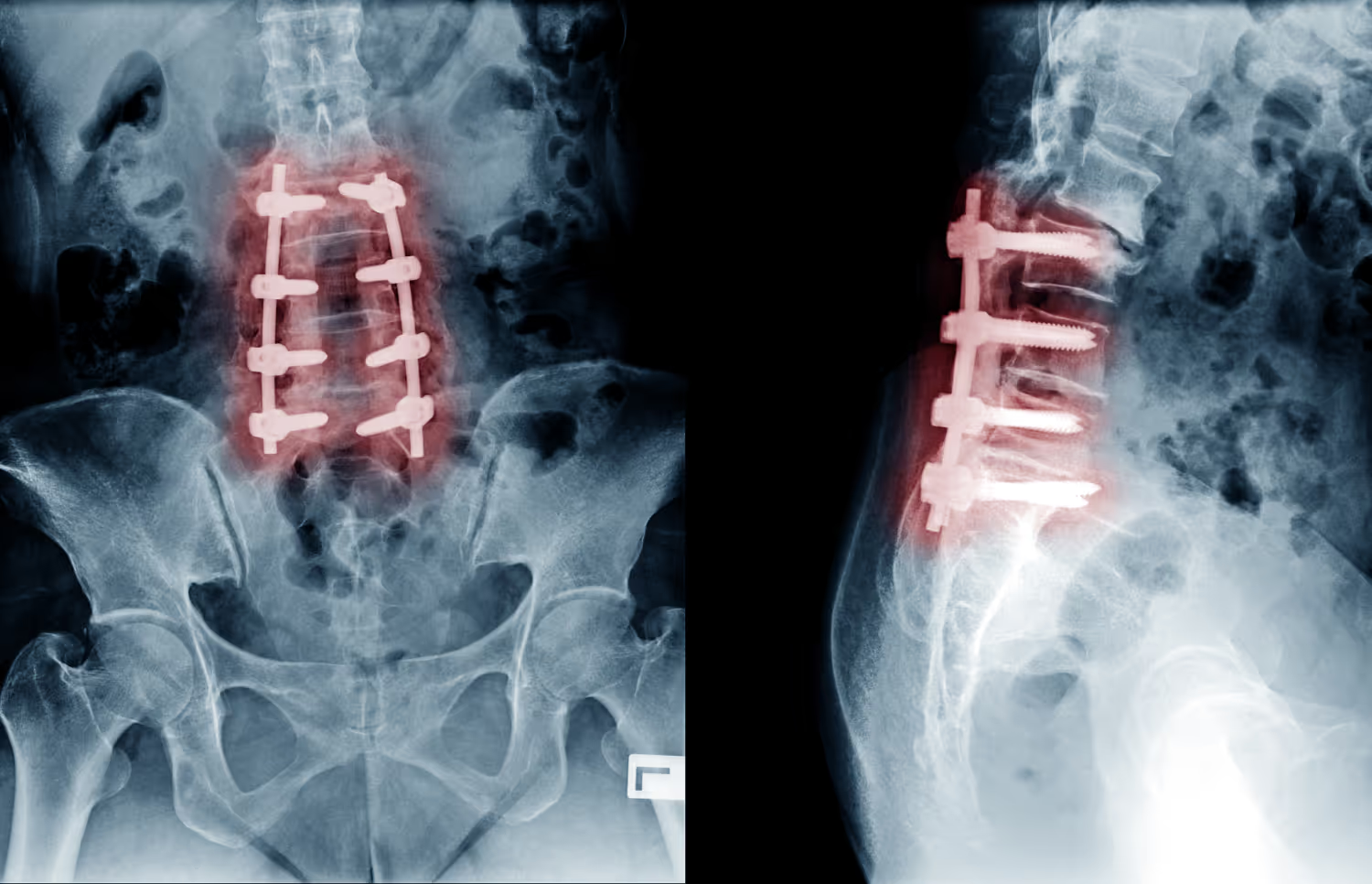
Post-laminectomy syndrome is a condition that can occur following spinal laminectomy surgery, an intervention designed to alleviate pressure on the spinal cord or nerves. While navigating this condition can feel overwhelming, we’re here to help break it down and provide a further understanding of various risk factors and potential solutions with Carda Health.
What Is Spinal Laminectomy Surgery?
In order to fully grasp the concept of post-laminectomy syndrome, it's essential to understand the procedure that precedes it: spinal laminectomy surgery.
This surgery, also known as decompression surgery, involves removing a portion of the vertebral bone called the lamina. The goal of the procedure is to alleviate pressure on the spinal cord or nerves, which may be caused by a variety of conditions, such as herniated discs, spinal stenosis, or tumors.
The surgery is considered a clinically-proven solution, especially for those who have experienced debilitating symptoms or loss of function due to nerve compression. But while the procedure can offer significant relief from symptoms, it’s not without potential complications, one of which is post-laminectomy syndrome.
What Is Post Laminectomy Syndrome?
Post-laminectomy syndrome is an uncomfortable condition that can occasionally occur after laminectomy surgery. Understanding the symptoms, causes, and risk factors of post-laminectomy syndrome can help you know when it’s time to speak to your healthcare provider about potential complications after laminectomy surgery.
Symptoms
Post-laminectomy syndrome, often referred to as failed back surgery syndrome, is a condition that can occur following spinal laminectomy surgery. It's characterized by persistent pain in the back or legs, despite the surgical intervention.
The nature of the pain may vary from person to person – some may experience a dull, aching sensation, while others might suffer from sharp, stabbing pains.
Some individuals may also feel a tingling or numbness in their extremities or have difficulty walking. Others might have changes in their bowel or bladder function. It’s important to keep in mind that the symptoms may differ in intensity and duration from one individual to another.
Causes
The causes of post-laminectomy syndrome are multifaceted and can stem from a variety of sources. One common cause is nerve damage that occurred during surgery, while in other cases, the surgery might not have fully addressed the initial cause of the nerve compression.
Another possible cause could be scar tissue formation around the nerve root following the procedure. Some individuals may develop new spinal conditions or degenerative changes in the spine that were not present at the time of the original surgery.
Risk Factors
Several factors can increase an individual's likelihood of developing post-laminectomy syndrome. These include:
Smoking: Because nicotine may reduce blood flow, smoking can slow the post-surgery healing process and increase the risk of complications, including post-laminectomy syndrome.
Obesity: Obesity may put added strain on the spine and can exacerbate pre-existing spinal conditions. It may also increase the risk of complications during and after surgery, including the development of post-laminectomy syndrome.
Multiple back surgeries: Undergoing multiple back surgeries can lead to increased scar tissue formation and a higher risk of complications during and after surgery.
Systemic diseases like diabetes: Diabetes can impact the body's healing process, potentially complicating recovery after surgery. Poorly controlled blood sugar levels can also increase post-surgical complications.
Certain psychological factors: Conditions like anxiety or depression can amplify perceived pain and impact post-surgery engagement in beneficial activities. Finding techniques to help manage these factors, such as breathing exercises, meditation, keeping a gratitude journal, or speaking to a therapist, can help manage stress levels and reduce their impact on your recovery process.
While any of these factors may increase the risk, they do not necessarily guarantee the onset of post-laminectomy syndrome. The condition can occur even in the absence of these risk factors.
It’s always best to have an open conversation with your healthcare provider about your risks and concerns before undergoing a spinal laminectomy procedure. At Carda Health, we understand that dealing with health conditions can be challenging, but remember, there's a community here to support you every step of the way.
How Is Post Laminectomy Syndrome Diagnosed?
Diagnosing post-laminectomy syndrome involves a comprehensive approach that considers your medical history, the nature and severity of your symptoms, and the results of any necessary diagnostic tests.
Initially, your healthcare provider will conduct a thorough physical examination and discuss your symptoms with you in detail. You might be asked about the location, severity, and duration of your pain, as well as any associated symptoms you might have.
Further investigation may require diagnostic tests, such as MRI or CT scans, to help visualize your spine and assess any changes that may have occurred since your initial surgery. Electromyography (EMG) may also be used to evaluate the electrical activity of your muscles and detect any nerve or muscle abnormalities.
It's important to note that diagnosing post-laminectomy syndrome can be complex, as the condition can present symptoms similar to other spinal disorders. A detailed evaluation can help differentiate post-laminectomy syndrome from other possible conditions.
How Is Post Laminectomy Syndrome Treated?
If you are suffering from post-laminectomy syndrome, there are a few options available that can help support your recovery.
Medications
Post-laminectomy syndrome treatment typically involves a multi-faceted approach and is largely centered on managing symptoms, particularly pain. A doctor may prescribe medications, including pain relievers, anti-inflammatories, or nerve pain medications.
But, it’s important to understand that while these can help manage the symptoms, they do not necessarily address the underlying causes of post-laminectomy syndrome.
Interventions
Beyond medication, a variety of interventions might be used to alleviate symptoms. These could include physiotherapy to improve mobility and strength, nerve block injections to numb the affected nerves, or spinal cord stimulation, a procedure that uses electrical currents to block pain signals.
Surgery
In some cases, a second surgical procedure might be necessary. This is typically considered when other treatment methods have been unsuccessful or when imaging tests show a physical problem that can be corrected with surgery.
However, it’s crucial to remember that the decision to undergo further surgery should be made after thorough discussions with your healthcare provider about the potential risks, benefits, and alternatives.
Coping with Post Laminectomy Syndrome
Navigating life with post-laminectomy syndrome can indeed be challenging, but remember that you're not alone. Here at Carda Health, we advocate for a proactive approach toward managing your overall health and improving your quality of life.
Firstly, it's vital to maintain regular communication with your healthcare provider. This can ensure that any changes in your condition are promptly addressed and your treatment plan can be adjusted accordingly.
Engaging in light physical activity, as recommended by your healthcare provider, can help improve your mobility and potentially reduce discomfort. However, it's important that any exercise regimen be carried out under professional supervision to avoid any potential harm.
At Carda Health, our clinical exercise physiologists are here to support you as you navigate this part of your post-surgery recovery plan. Our virtual approach to cardiac rehabilitation means that you can engage in these activities from the comfort of your home, with the added reassurance of a personalized care plan and professional monitoring.
We also champion holistic health techniques, such as deep breathing, meditation, and gentle yoga. These practices can help reduce stress, manage symptoms, and encourage a positive mindset. Our team provides guidance on how to seamlessly integrate these mind-body therapies into your daily routine and offers check-in calls to make sure you are feeling supported and at ease with each step of your recovery journey.
Joining a support group can also provide emotional comfort, as speaking with individuals who are undergoing similar experiences can offer a sense of camaraderie and shared understanding.
How Can You Prevent Post Laminectomy Syndrome?
While it may not be possible to prevent post-laminectomy syndrome entirely, there are certain strategies that can help minimize its likelihood.
One of the key steps lies in the pre-surgical phase. It’s essential to ensure you fully understand the procedure, its risks, benefits, and alternatives.
Make sure to have an open dialogue with your healthcare provider, and don’t hesitate to ask questions. This can help make sure that your expectations align with what the surgery can realistically accomplish.
Maintaining a healthy lifestyle is also beneficial. Regular exercise, a balanced diet, and avoiding habits like smoking can help improve your overall health and potentially enhance your recovery from surgery.
At Carda Health, we can support you in maintaining a regular exercise routine and balanced nutrition plan aimed to support your overall health and potentially encourage your recovery from surgery.
Following surgery, adhering to all post-operative instructions is also crucial. This includes taking prescribed medications, attending follow-up appointments, and participating in any recommended rehabilitation programs.

The Bottom Line
Although complex, post-laminectomy syndrome can be managed with the right strategies and support. At Carda Health, we recognize the challenges this condition can bring and are committed to offering a personalized, virtual approach to cardiac rehab that encompasses both physical and mental wellness.
With a team of clinical exercise physiologists dedicated to creating tailored exercise and nutrition plans, alongside guidance on integrating holistic techniques, it’s our goal to support your recovery journey. Our approach is grounded in empowering individuals to be proactive in their health journey, fostering resilience, and promoting an improved quality of life.
Sources:
Post-Laminectomy Syndrome | Novus Spine & Pain Center

.avif)






